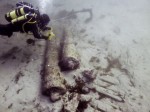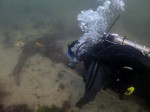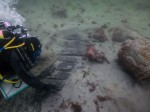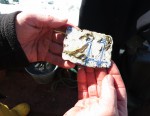 The wreck of a 17th or early 18th-century ship discovered on the north west coast of Scotland near the village of Drumbeg has been designated a Historic Marine Protected Area (MPA) by Fiona Hyslop, the Cabinet Secretary for Culture and External Affairs. Scotland’s Marine Act allowing for the creation of MPAs was passed in 2010 but this is the first time the power has been invoked. The designation grants statutory protection to marine sites deemed important to the country’s natural and cultural heritage.
The wreck of a 17th or early 18th-century ship discovered on the north west coast of Scotland near the village of Drumbeg has been designated a Historic Marine Protected Area (MPA) by Fiona Hyslop, the Cabinet Secretary for Culture and External Affairs. Scotland’s Marine Act allowing for the creation of MPAs was passed in 2010 but this is the first time the power has been invoked. The designation grants statutory protection to marine sites deemed important to the country’s natural and cultural heritage.
Fiona Hyslop said: “It is important to safeguard our most important underwater heritage sites in the seas around Scotland so that they can be valued and enjoyed and I am pleased to announce our first Historic MPAs as a first step to achieving that aim.
“Historic MPAs provide protection based on the principle of sustainable use. We hope that visitors will have more opportunities to enjoy these sites on a ‘look but don’t touch’ basis, and will also gain a better understanding of the importance of our marine heritage.”
Another six marine sites — the oldest a late 16th or early 17th century merchant vessel and the newest a World War I aircraft carrier — currently protected under the 1973 Protection of Wrecks Act are also in consideration.
 The Drumbeg wreck was first encountered in 1994 by local diver Ewen Mackay who found an arrow-shaped anchor embedded upright in the sand. In 1999, he and his friend Michael Errington were scallop diving in the area when Errington mentioned he had seen what looked like metal pipes in a previous dive nearby. Together they explored the “pipes” and confirmed that, as they suspected, the pipes were actually cannons. The two continued to explore the area for a few years. They found some cannon balls, another anchor and some wooden planking which turned out to be a very well-preserved 35-foot length of hull.
The Drumbeg wreck was first encountered in 1994 by local diver Ewen Mackay who found an arrow-shaped anchor embedded upright in the sand. In 1999, he and his friend Michael Errington were scallop diving in the area when Errington mentioned he had seen what looked like metal pipes in a previous dive nearby. Together they explored the “pipes” and confirmed that, as they suspected, the pipes were actually cannons. The two continued to explore the area for a few years. They found some cannon balls, another anchor and some wooden planking which turned out to be a very well-preserved 35-foot length of hull.
 In 2002 they reported the discovery to the Receiver of Wreck, an excellent job title by any standard, and continued their investigations of the site. Mackay had worked as a volunteer at underwater archaeological sites in Bermuda, so he knew the wooden planks might be datable via dendrochronological analysis. He tried to send some samples to a lab in Edingburgh, but they were not suitable for testing and further attempts would be too costly for his purse.
In 2002 they reported the discovery to the Receiver of Wreck, an excellent job title by any standard, and continued their investigations of the site. Mackay had worked as a volunteer at underwater archaeological sites in Bermuda, so he knew the wooden planks might be datable via dendrochronological analysis. He tried to send some samples to a lab in Edingburgh, but they were not suitable for testing and further attempts would be too costly for his purse.
 Almost a decade after their initial reporting of the find, a local historian suggested the divers contact Historic Scotland. The organization decided to fund an archaeological survey done by actual professionals. They commissioned Wessex Archaeology to survey the site. In mid-September of 2012, McKay took the marine archaeologists to the wreck site. A four-person scuba team of archaeologists measured and photographed the shipwreck. Visibility was so good they were able to use photogrammetry — many pictures taken from every possible angle — to create 3D models of the remains.
Almost a decade after their initial reporting of the find, a local historian suggested the divers contact Historic Scotland. The organization decided to fund an archaeological survey done by actual professionals. They commissioned Wessex Archaeology to survey the site. In mid-September of 2012, McKay took the marine archaeologists to the wreck site. A four-person scuba team of archaeologists measured and photographed the shipwreck. Visibility was so good they were able to use photogrammetry — many pictures taken from every possible angle — to create 3D models of the remains.
 The wreck has not been identified, but a cannon expert determined from photographs and measurements that the three cannons were Swedish in manufacture from the 17th or early 18th century. At this time Sweden did a brisk trade in cannon. The Dutch, for instance, turned to Sweden for pretty much all of their iron gun needs. Another artifact discovered also suggests a possible Dutch origin for the vessel. A broken Delft tile was found just north of the three cannons. It depicts a three-masted ship flying the Dutch flag, and was made between 1650 and 1750.
The wreck has not been identified, but a cannon expert determined from photographs and measurements that the three cannons were Swedish in manufacture from the 17th or early 18th century. At this time Sweden did a brisk trade in cannon. The Dutch, for instance, turned to Sweden for pretty much all of their iron gun needs. Another artifact discovered also suggests a possible Dutch origin for the vessel. A broken Delft tile was found just north of the three cannons. It depicts a three-masted ship flying the Dutch flag, and was made between 1650 and 1750.
One possible theory is that it was a Dutch East India Company merchant ship. They were known to travel the coast of Scotland to avoid the terrors of the English Channel. Records of company shipwrecks are extant, however, and none of the known ships from this date range are listed as having gone down around Drumbeg. Documentary research is ongoing.